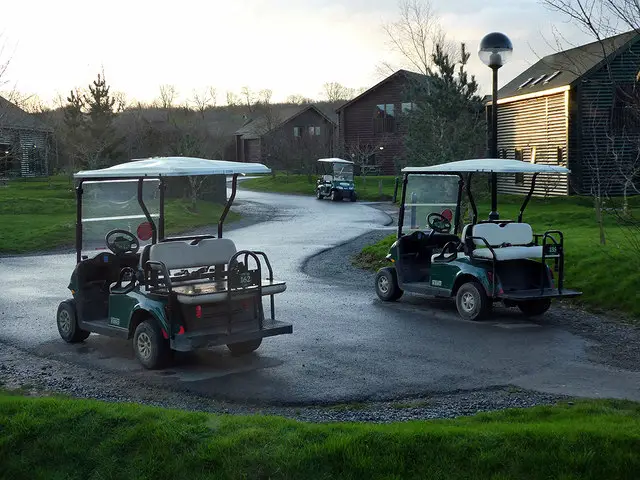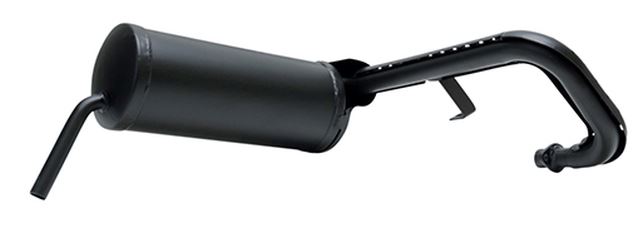You hop in to your your gas-powered golf cart, turn it on, and are ready to go, but all of a sudden, you hear a loud “pop”! Then you wonder: why is my golf cart backfiring?
Golf carts are a great way to get around the golf course, but sometimes a golf cart engine will backfire and can be a cause for concern.
This article will explain what causes a golf cart backfiring and how to fix it.
We’ll also cover some preventative measures you can take to avoid this problem altogether.
What Is A Golf Cart Backfire?
A golf cart backfire is a tapping or popping sound (usually loud and abrupt) that occurs when a piston slams against the cylinder head in your golf cart engine.
A backfiring golf cart is not something that you should ignore.
It is a sign that something needs attention in your cart’s engine and will only get worse or do additional damage over time.
There are several reasons that can cause this, which we’ve detailed below in this guide.
Why Is My Golf Cart Backfiring?

Obviously, hearing your golf cart backfire is concerning for any cart owner.
You’ll want to get to the bottom of things to resolve the issue right away.
There are a few reasons why your golf cart might be backfiring, which we’ll go through now.
These really come down to four main reasons:
- Timing issues
- Unbalanced Fuel Mix
- Carbon Buildup on the Pistons & Valves
- Carbon Buildup in the Muffler
How To Stop A Golf Cart From Backfiring
In order to stop your golf cart backfire issue, you’ll need to first diagnose which of the above causes is the culprit, then go about fixing it.
Fortunately, we’ve outlined how to determine the cause and how to resolve each of them below.
Note: you should follow these causes in order to help you diagnose things quickly.
Timing Issues
Backfiring can occur if your gas golf cart’s engine hasn’t been balanced properly.
Your golf cart has a microswitch that moves prior to the accelerator throttle plate engages.
If the microswitch is not adjusted properly, it can cause a delay between the pedal and the throttle plate, which is a timing issue.
This will send too little or too much fuel to the accelerator, which causes a backfire.
How To Test Your Golf Cart For Timing Issues
Turn off the golf cart’s ignition
Remove the golf cart seat
With the cart off, slowly push down on the accelerator pedal while listening for a ‘click’ sound.
The ‘click’ noise is the microswitch activating.
The microswitch is usually located inside the engine or might be near the pedal (depending on the make and model of your golf cart).
Take note of the throttle and see if it moves as the accelerator pedal is pushed down.
If the throttle moves before you heard the ‘click’ of the microswitch, you have found the cause of your golf cart backfiring.
How To Fix Golf Cart Timing Issues
You should see a cable sliding through a hole in the throttle lever.
This is your accelerator cable.
Loosen the nut holding the cable in place.
Push the pedal down until you hear a click, and note the position of the cable when doing so.
Tighten the cable to the new position and your throttle timing should now be correct.
Re-attach the golf cart seat and ride it around for a bit.
If it accelerates smoothly with no backfires, you’re good to go.
If you still have golf cart backfiring after adjusting this, it may be a sign of a larger problem, like a bent or obstructed throttle plate.
You can attempt this repair yourself, but it requires removing the whole carburetor which can be tough.
You may consider contacting a local golf cart repair shop to do the job.
Unbalanced Fuel Mix
If the balance of air and fuel is off, it can cause the combustion to take place outside of your golf cart’s engine cylinders, which will cause a backfire.
How To Test Golf Cart Unbalanced Fuel Mix
If you notice thick blue smoke or a sweet smell when your golf cart backfires, this is a sign that the fuel mixture is too rich.
Your fuel mixture is considered “rich” when there’s too much fuel in the ratio.
How To Fix Golf Cart Unbalanced Fuel Mix
The first thing to try is to cycle your engine.
Your golf cart’s carburetor has either a screw or lock nut on the bottom.
Start by loosening this up as much as possible, then slowly tighten it by one and a half turns until you get the fuel mixture dialed in.
If this doesn’t fully solve the problem, you can cycle the carburetor adjuster as well.
For four-cycle golf cart engines, you’ll notice a plastic cap on the top of the engine.
Turn this cap to the left to lower the level of fuel in the mixture, and turn it to the right to increase the amount of fuel in the mixture.
If that process doesn’t solve the problem, you can move on to adjusting the engine screw.
To do this, first turn off the engine and remove the drive belt.
Next, you can adjust the screw incrementally until the engine is running perfectly.
Once you get that screw properly adjusted, replace the drive belt and start up your golf cart to test it for backfiring again.
Carbon Buildup On Pistons And Valves
This is more often found on older golf carts, but carbon can build up on the valves and pistons in the engine over time.
That carbon can ignite due to the friction in the pistons, causing golf cart backfiring and can also cause additional damage.
Diagnosing and repairing this issue is not the easiest, so don’t hesitate to reach out to a local golf cart repair shop if necessary.
How To Fix Carbon Buildup On Golf Carts
You’ll first need to turn off the engine and wait at least an hour after running it to allow the engine to cool down.
Next, remove the engine head so you can see the pistons.
Visually inspect the tops and sides of the piston for carbon buildup, and use a scraping tool to break it off.
Be careful to not scrape too hard so you don’t damage the pistons.
Also take plenty of care to clean up any loose carbon pieces or flakes using a shop vac.
The leftover loose carbon pieces can ignite and cause further backfires or damage, so you shouldn’t skip the cleanup step!
Carbon Buildup In Muffler
Just like on your pistons, carbon can build up in the muffler over time.
This buildup can cause sporadic golf cart backfire problems, but is a little tough to diagnose.

The main reason is that muffler backfiring won’t occur until the muffler is warmed up and you’ve been driving the golf cart for a bit.
Additionally, the muffler won’t backfire consistently.
If you’re experiencing golf cart backfiring only after the cart has been running for a while, this may be your issue.
How To Fix Golf Cart Muffler Backfiring
Fortunately, this is a pretty simple process.
It just involves heating up the muffler, which will break down the carbon buildup inside.
Most folks who do their own repairs will place the muffler on a barbecue grill (not over open flame, but higher up) and allow the heat to do the work for them.
Let it sit on there for 30-45 minutes, then let it cool for 2-3 hours before handling it.
Most of the carbon buildup should be reduced to ash and you can shake it out of the muffler.
Reattach your golf cart muffler, let the cart warm up and drive it around for a bit, and see if this solves your issue.
What Makes A Golf Cart Backfire? Check These Other Fixes

There are few other “easy” fixes that could cause backfiring:
Excess Fuel In Carburetor: turn off the choke and press on the gas pedal several times to remove it, then test again.
Leak In Air Box: inspect the air box to ensure it has a complete seal. Check the lid, hooks, and gasket for damage or warping, and replace if necessary.
Battery Hooked Up Incorrectly: Check your batteries to ensure they’re not hooked up the wrong way, which can use the engine to turn in the opposite direction or screw up the valve timing. Reseat the golf cart battery properly to fix the issue.
Exhaust Manifold Bolts Are Loose: Check the bolts on your exhaust manifold. If they’re loose, tighten them up.
Gas In The Exhaust: If you’re getting extra gas in your exhaust, you may need to replace or rebuild the carburetor and check the valves to get everything running right.
What If The Golf Cart Backfires When I Let Off The Gas?
If your golf cart backfires when you let off the gas, there’s two possible reasons this is happening:
Either the carburetor butterfly isn’t closing completely, or there’s an exhaust gasket that’s faulty and suctioning air.
Usually you can adjust the return spring on your carburetor to the ‘closed’ position and this will solve the problem.
Golf Cart Backfires Going Downhill? Here’s What To Do
If you’ve already ruled out the other causes above and your golf cart backfires going downhill, check out this next solution.
Sometimes your rev limiter will move out of the proper position at full throttle. Try backing the setting off a bit to see if that fixes the issue.
How To Prevent Your Golf Cart From Backfiring
Now that you know some of the reasons why your gas golf cart might be backfiring, let’s talk about how you can prevent it.
As we mentioned before, one of the main causes of backfiring is incorrect timing.
To avoid this, make sure you keep up with your golf cart maintenance and have a professional tune-up at least once a year.
Another way to help prevent backfiring is by using higher quality gas.
Go for high octane gas to help keep your engine clean and running smoothly.
Wrapping Up Our Guide To Golf Cart Backfiring Causes & Fixes
We hope this post has helped you figure out why your golf cart backfires and how to fix it!
If you’re not comfortable diagnosing or fixing the issue yourself, find golf cart repair near you for assistance.
Be sure to check out our helpful golf cart guides while you’re here:
- How to test a golf cart motor
- What to do if your golf cart won’t start
- Our complete guide to golf cart battery maintenance
- How to add water to a golf cart battery
- How much are golf cart batteries?
- How long does it take to charge a golf cart?
- The best golf cart bluetooth speakers
- The best golf cart locks
- Installing a golf cart roll cage
- How to install a golf cart car seat
- How much does a golf cart weigh?
- Golf cart dimensions

